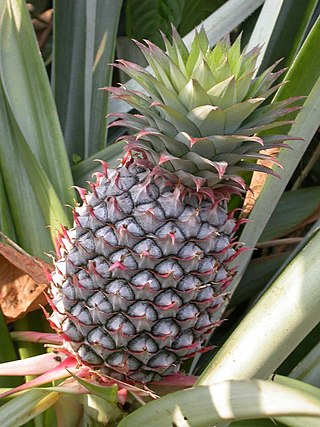
The Bromeliaceae are a family of monocot flowering plants of about 80 genera and 3700 known species, native mainly to the tropical Americas, with several species found in the American subtropics and one in tropical west Africa, Pitcairnia feliciana.

Tillandsia is a genus of around 650 species of evergreen, perennial flowering plants in the family Bromeliaceae, native to the forests, mountains and deserts of the Neotropics, from northern Mexico and the southeastern United States to Mesoamerica and the Caribbean to central Argentina. Their leaves, more or less silvery in color, are covered with specialized cells (trichomes) capable of rapidly absorbing water that gathers on them.
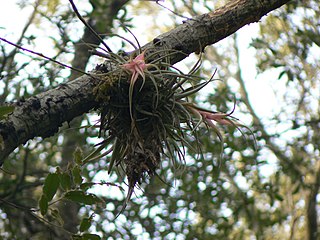
Tillandsia erubescens is a species of epiphytic plants of the genus Tillandsia. This species is endemic to Mexico, found over much of the country from Chihuahua to Oaxaca.
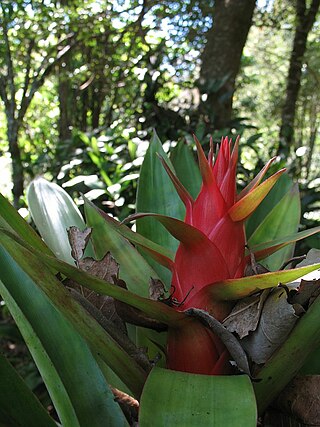
Tillandsia imperialis is an epiphytic species of flowering plant in the genus Tillandsia. This species is endemic to Mexico, specifically the states Hidalgo, Oaxaca, Puebla, Querétaro, and Veracruz, at elevations ranging from 800 to 2,600 meters. Its distribution is generally on the eastern portion of the eastern Sierra Madre Mountains and the eastern portion of the Trans-Mexican Volcanic Belt. This species is primarily epiphytic to the branches and holes of the tree species Pinus patula and Quercus laurina, or on lianas of the same trees, in moist cloud forests. This bromeliad prefers moist conditions and does not tolerate extended periods of drought or low humidity.
Tillandsia ventanaensis is an epiphytic species in the genus Tillandsia first described in 1995. This species is endemic only to the state of Durango, Mexico between elevations of 1,800–2,000 meters, in the vicinity of the border of Sinaloa in the Sierra de las Ventanas. This plant is stemless, flowering erect 35–55 cm high, with rigid leaves up to 55 cm long.
Tillandsia violacea is a species of epiphytic flowering plant in the family Bromeliaceae. It is endemic to Mexico, particularly to the Central Mexican Plateau. This species' habitat is at elevations between 600 and 3,100 meters, and is epiphytic to large trees in humid temperate forests, primarily the species Abies religiosa, Quercus rugosa, and Quercus laurina. In particular, it is a common epiphyte of the temperate pine forests of Hidalgo state, including El Chico National Park. Its range extends to the states of Guerrero, Jalisco, state of Mexico, Michoacán, Morelos, Oaxaca, and Veracruz. Due to its high-elevation habitat, this bromeliad species has tolerance to sub-freezing conditions.

Tillandsia juncea is a species of flowering plant in the genus Tillandsia. This species is native to northern South America, Central America, Mexico and the West Indies.

Tillandsia polystachia is a species of flowering plant in the genus Tillandsia. This species is native to Central America, the West Indies, Bolivia, Colombia, Brazil, Ecuador, Mexico and Venezuela.
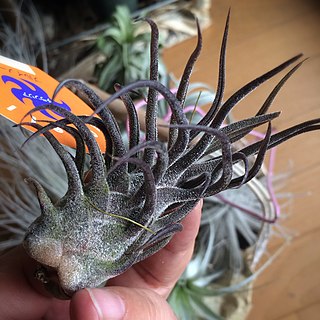
Tillandsia pruinosa, is a species of flowering plant in the family Bromeliaceae. It is commonly known as the fuzzywuzzy airplant. This species is native to northern South America, Central America, southern Mexico, the West Indies and Florida.

Tillandsia fasciculata, commonly known as the giant airplant, giant wild pine, or cardinal airplant, is a species of bromeliad that is native to Central America, Mexico, the West Indies, northern South America, and the southeastern United States. Within the United States, this airplant is at risk of extirpation from the Mexican bromeliad weevil, Metamasius callizona. A related plant, Tillandsia utriculata, sometimes called the "wild pine", is endemic to the same areas.
Tillandsia festucoides, commonly known as the fescue airplant, is a species of bromeliad that is native to the Greater Antilles, Mexico, the Cayman Islands, and Central America.
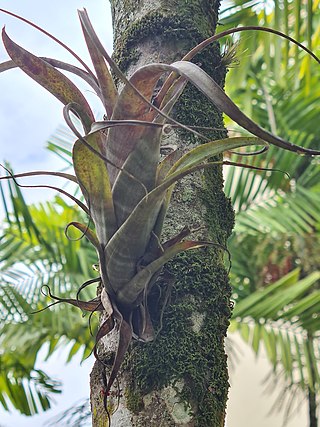
Tillandsia flexuosa, the twisted airplant, is a species of bromeliad in the genus Tillandsia. This species is native to Central America, southeastern Mexico, northern South America and the United States (Florida).

Tillandsia ionantha, the air plant, is a species of plant in the genus Tillandsia. This species is native to Central America and Mexico. It is also reportedly naturalized in Broward County, Florida.
Tillandsia makoyana is a species of flowering plant in the Bromeliaceae family. This species is native to Costa Rica and Mexico.
Tillandsia polita is a species of flowering plant in the family Bromeliaceae, native to Mexico and Central America. It was first described by Lyman Bradford Smith in 1941. As of October 2022, the Encyclopaedia of Bromeliads regarded it as a natural hybrid of Tillandsia rodrigueziana and Tillandsia rotundata.

Tillandsia schiedeana is a species of flowering plant in the genus Tillandsia. It was named for the collector Christian Julius Wilhelm Schiede. As an epiphyte, it is found "growing in open tropical forests, and saxicolous, growing on cacti and burseras on steep dry slopes in semiarid regions in Mexico, Central America, West Indies, Venezuela, and Colombia at elevations of 750 to 5,500 feet."

Tillandsia utriculata, commonly known as the spreading airplant, the giant airplant, or wild pine is a species of bromeliad that is native to Florida and Georgia in the United States, the Caribbean, southern and eastern Mexico, Central America, and Venezuela.

Guzmania musaica is a plant species in the genus Guzmania. This species is native to Costa Rica, Panama, Ecuador, Venezuela and Colombia.

Tillandsia denudata is a species of flowering plant in the Bromeliaceae family. It is native to Bolivia, Venezuela and Ecuador.
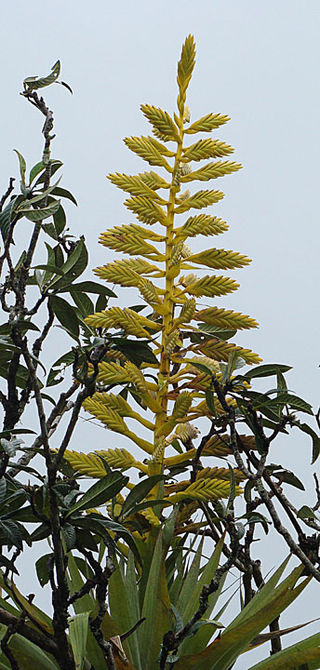
Tillandsia oerstediana is a species of flowering plant in the bromeliad family Bromeliaceae. It is an epiphyte that is found on open forested slopes in wet tropical areas. Tillandsia oerstediana is native to Costa Rica and western Panama.














